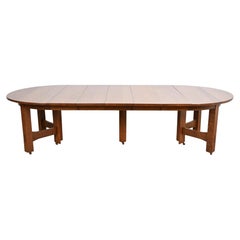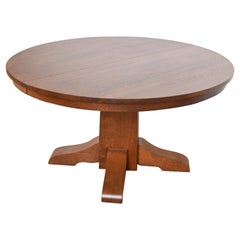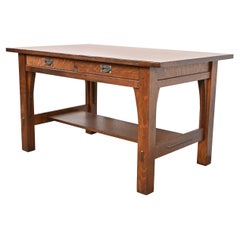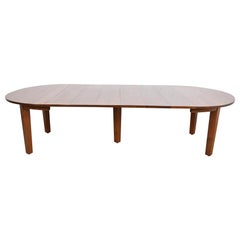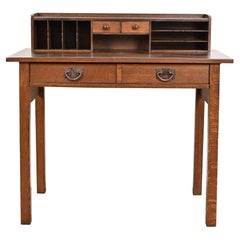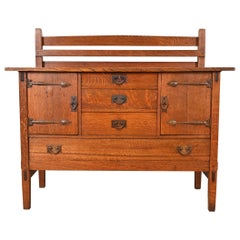Gustav Stickley Furniture
Gustav Stickley was one of the principal figures in the American Arts and Crafts movement and the creator of the Craftsman style. As a furniture designer and publisher of the magazine The Craftsman, he adopted many of the ideals of the British design reform movement and popularized both its philosophy and its aesthetics in the United States.
Born in Wisconsin, Stickley moved with his family to Pennsylvania when he was a teenager and began working in his uncle’s chair factory in the town of Brandt. There, he learned the techniques of late-19th-century furniture making at a time when the vogue was for Victorian revival furniture, which was characterized by extensive ornamentation.
In 1883, Stickley established a furniture company called Stickley Brothers with two of his brothers, Albert and Charles (Gustav’s other siblings, Leopold and John George, would later form L & J.G. Stickley Inc.). When Stickley Brothers foundered, he partnered five years later with salesman Elgin Simonds to form a new firm, Stickley & Simonds, which produced traditional furniture that appealed to the burgeoning American middle class. The success of this venture enabled Stickley to travel to Europe, where he discovered the writings of John Ruskin and William Morris, the two preeminent thinkers of the British Arts and Crafts movement. Stickley also traveled to France, where the Art Nouveau movement impressed him with its imaginative designs and skilled craftsmanship.
Stickley parted ways with Simonds at the turn of the 20th century and decided to focus his creative energies on producing furniture in what became known as the Craftsman style, incorporating some of the elements of the designs and movements he had encountered in Europe.
The pieces Stickley created, which he stamped with the logo of a joiner’s compass, were rectilinear, largely free of ornament, made of oak, and built in such a way that the nature of their construction was plainly visible — all reflections of the tenets of the Arts and Crafts movement. While some people referred to Stickley’s furniture as Mission furniture — a term that references the furnishings of the Spanish missions in California — Gustav commonly called his work “Craftsman” owing to the inspiration he found in the British Arts and Crafts movement.
Stickley benches and rocking chairs were popular, and his leather-upholstered armchairs combine practicality, comfort and an understated silhouette. He also made side tables — an unusual example designed during the early 20th century was adorned with an octagonal Grueby Pottery tile in a cool shade of green, which made it an ideal piece for an art pottery collector.
In 1901, Stickley launched The Craftsman magazine, which contained articles on all manner of domestic topics, from gardening and cooking to art and design, as well as poetry and fiction. In addition to popularizing Stickely’s own designs, the magazine acquainted Americans with the Arts and Crafts style in all its forms through its graphic design and the bungalows, art pottery, and hammered-copper lamps pictured in its pages. It also encouraged readers to practice craft themselves, promoting an early form of the do-it-yourself ethos.
In 1904, Stickley founded the Craftsman Home Builders' Club, which allowed subscribers to his magazine to order architectural plans for the Arts and Crafts–style structures that were featured in its pages; eventually, this became one of its most popular features.
An ill-timed attempt to set up a New York showroom led to Stickley’s filing for bankruptcy in 1915. The outbreak of World War I, waning interest in the Arts and Crafts style, and increased competition all conspired to thwart Stickley's efforts. The Craftsman ceased publication a year later. When he died, in 1942, Arts and Crafts had been replaced by modernism as the favored aesthetic. It enjoyed a resurgence, however, in the 1970s, and Stickley is now regarded as one of the most important American designers in the first half of the 20th century.
Find antique Gustav Stickley tables, seating and other furniture on 1stDibs.
Early 1900s American Arts and Crafts Antique Gustav Stickley Furniture
Oak
Early 20th Century American Arts and Crafts Gustav Stickley Furniture
Oak
Early 20th Century American Arts and Crafts Gustav Stickley Furniture
Copper
Early 1900s American Arts and Crafts Antique Gustav Stickley Furniture
Oak
Early 20th Century American Arts and Crafts Gustav Stickley Furniture
Copper
Early 1900s American Arts and Crafts Antique Gustav Stickley Furniture
Copper
Early 1900s American Arts and Crafts Antique Gustav Stickley Furniture
Copper
Early 20th Century American Arts and Crafts Gustav Stickley Furniture
Copper
Early 1900s American Arts and Crafts Antique Gustav Stickley Furniture
Oak
Early 20th Century American Arts and Crafts Gustav Stickley Furniture
Upholstery, Oak
Early 20th Century American Arts and Crafts Gustav Stickley Furniture
Copper
Early 20th Century American Arts and Crafts Gustav Stickley Furniture
Rush, Oak
Early 20th Century American Arts and Crafts Gustav Stickley Furniture
Copper
Early 20th Century American Arts and Crafts Gustav Stickley Furniture
Upholstery, Oak
21st Century and Contemporary American Mission Gustav Stickley Furniture
Metal
Early 20th Century American Arts and Crafts Gustav Stickley Furniture
Copper
Early 20th Century American Arts and Crafts Gustav Stickley Furniture
Cotton, Upholstery, Oak
Early 20th Century American Arts and Crafts Gustav Stickley Furniture
Leather, Cotton, Upholstery, Oak
Mid-20th Century American Arts and Crafts Gustav Stickley Furniture
Leather, Oak
20th Century American American Craftsman Gustav Stickley Furniture
Oak
Early 20th Century American Arts and Crafts Gustav Stickley Furniture
Copper
Early 20th Century American Arts and Crafts Gustav Stickley Furniture
Oak
Early 20th Century American Arts and Crafts Gustav Stickley Furniture
Leather, Burlap, Oak
Early 20th Century American Arts and Crafts Gustav Stickley Furniture
Leather, Upholstery, Cane, Oak
Early 20th Century North American Arts and Crafts Gustav Stickley Furniture
Oak
Early 1900s American Arts and Crafts Antique Gustav Stickley Furniture
Leather, Oak
Early 20th Century American Arts and Crafts Gustav Stickley Furniture
Leather, Cotton, Upholstery, Oak
Early 2000s American Mission Gustav Stickley Furniture
Metal
1910s American Arts and Crafts Vintage Gustav Stickley Furniture
Ceramic, Oak
Early 1900s American Arts and Crafts Antique Gustav Stickley Furniture
Oak
Late 20th Century American Arts and Crafts Gustav Stickley Furniture
Glass, Oak
Early 20th Century American Arts and Crafts Gustav Stickley Furniture
Oak
Early 1900s American Arts and Crafts Antique Gustav Stickley Furniture
Leather, Oak
Early 20th Century American Arts and Crafts Gustav Stickley Furniture
Copper
Early 1900s American Arts and Crafts Antique Gustav Stickley Furniture
Glass, Oak
Early 2000s American Arts and Crafts Gustav Stickley Furniture
Cherry
Early 20th Century American Arts and Crafts Gustav Stickley Furniture
Oak
Early 20th Century American Arts and Crafts Gustav Stickley Furniture
Oak
Early 20th Century American Arts and Crafts Gustav Stickley Furniture
Copper
Early 1900s American Arts and Crafts Antique Gustav Stickley Furniture
Oak
Early 20th Century American Arts and Crafts Gustav Stickley Furniture
Leather, Cotton, Upholstery, Oak
Early 20th Century American Arts and Crafts Gustav Stickley Furniture
Oak
Early 1900s American Arts and Crafts Antique Gustav Stickley Furniture
Wrought Iron
Early 20th Century American Arts and Crafts Gustav Stickley Furniture
Oak
Early 20th Century American Arts and Crafts Gustav Stickley Furniture
Oak
Early 20th Century American Arts and Crafts Gustav Stickley Furniture
Oak
Early 1900s American Arts and Crafts Antique Gustav Stickley Furniture
Oak
Early 20th Century American Arts and Crafts Gustav Stickley Furniture
Oak, Upholstery, Cotton, Leather
Early 20th Century American Arts and Crafts Gustav Stickley Furniture
Leather, Oak
Early 20th Century American Arts and Crafts Gustav Stickley Furniture
Iron
Early 20th Century American Arts and Crafts Gustav Stickley Furniture
Bronze
1910s American Arts and Crafts Vintage Gustav Stickley Furniture
Brass
Early 20th Century American Arts and Crafts Gustav Stickley Furniture
Oak
Early 20th Century American Arts and Crafts Gustav Stickley Furniture
Mahogany
Early 20th Century American Arts and Crafts Gustav Stickley Furniture
Oak
Early 20th Century American Arts and Crafts Gustav Stickley Furniture
Leather, Cotton, Upholstery, Oak
Early 20th Century American Arts and Crafts Gustav Stickley Furniture
Oak
Early 20th Century American Arts and Crafts Gustav Stickley Furniture
Leather, Oak
Gustav Stickley furniture for sale on 1stDibs.
Creators Similar to Gustav Stickley
- 1stDibs ExpertAugust 15, 2024To tell if a chair is a Stickley, look for the maker's mark, usually found underneath the seat. Depending on the age of the chair, it may appear on a paper or metal label, be burned into the frame or be stamped on it with ink. Stickley used a number of different markings over the years, but has images of most of its historic marks available for viewing on the maker's official website. You can compare the markings on your chair to those found in this reference. If you need assistance, enlist the help of a certified appraiser or knowledgeable antique dealer. On 1stDibs, explore a collection of Stickley chairs.
- How do you identify a Stickley?1 Answer1stDibs ExpertSeptember 23, 2024To identify a Stickley, look for the maker's label or stamp. It's usually located in an inconspicuous place, such as the underside of a seat or tabletop or on the bottom or back of a case good. The official Stickley website has a photo guide to its markings. By comparing the hallmark on your piece to images shared in this reference, you can determine whether your piece is a Stickley and learn its approximate age. If you need help with the process, consider using the services of a certified appraiser or knowledgeable antique dealer. On 1stDibs, find a collection of Stickley furniture.
- Is Stickley worth the price?1 Answer1stDibs ExpertMay 3, 2024Yes, Stickley is generally worth the price. Online reviewers frequently state that the furniture maker's pieces hold up to the effects of daily use and continue to remain like new for years to come. And because Gustav Stickley is now regarded as one of the most important American designers in the first half of the 20th century, this can have a positive effect on the long-term value of the brand’s furniture. Indeed, Stickley furnishings tend to retain their value, allowing owners to recoup their investment if they ever decide to replace their furniture when redecorating or downsizing. Find a variety of Stickley furniture on 1stDibs.
- 1stDibs ExpertOctober 24, 2024To tell if it's a Stickley, look for a maker's marking. You will usually find it stamped in ink, branded onto the wood, printed on a paper label or etched onto a metal tag. Over its long history, the furniture maker has used many different hallmarks. Later pieces often simply say "Stickley," while older ones may display “L & JG Stickley” markings. You can find images of all Stickely's maker's marks on trusted online resources. If you can't find a marking, a certified appraiser or knowledgeable antique dealer can help you determine if your piece is a Stickley. On 1stDibs, explore a wide variety of Stickley furniture.
- 1stDibs ExpertNovember 26, 2024To identify a Stickley chair, look under the seat and on the legs for a paper label or metal tag. Stickley has modified its markings over time, so you can use these to determine the approximate age of your chair as well as to figure out if it is a Stickley. You can find image guides to interpreting Stickley maker’s marks on trusted online resources. Alternatively, you can have a certified appraiser or experienced antique dealer perform the identification process for you. On 1stDibs, find a selection of Stickley chairs.
- 1stDibs ExpertSeptember 9, 2024To find out what your antique chair is worth, you can conduct research using trusted online resources. Specifically, study the sales history for pieces similar to yours in terms of maker, age, style and type. Because the condition of your chair will also impact its value, you may wish to have a certified appraiser or knowledgeable antique dealer inspect and evaluate your piece. Find a collection of antique chairs on 1stDibs.
